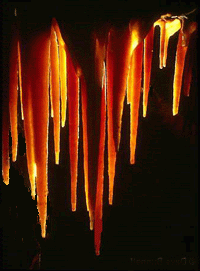Stalactites, Stalagmites, and Stalacto-Stalagmites
(also known as "dripstones")
Caves and drippings
A stalagmite (Greek stalagma, "drip") is a type of speleothem formed by the deposit of calcium carbonate which rises from the floor of a limestone cave due to the dripping of mineralized solutions. A speleothem (from Greek for "cave deposit") is a secondary mineral deposited in a cave by the action of water and it is a formal term for what is also known as a "cave formation".
The corresponding formation on the ceiling above a stalagmite is known as a stalactite. Should both of these formations grow together, meeting in the middle, the resultant formation is known as a column or pillar and is also defined as dripstone or stalacto-stalagmites. The term "stalagmite" is derived from Greek meaning that which drops; "stalactite," comes from Greek meaning to fall in drops.
Mnemonic devices to help you distinguish between
stalactite and stalagmite
There are various mnemonic methods to help remember which hangs from the ceiling (stalactite) and which comes up from the floor (stalagmite):
- StalaCtite has a "c" for "ceiling".
- StalaGmite has a "g" for "ground".
- Stalactite is stretched "tite" (tight) by hanging from the ceiling.
- Stalagmite pushes up with all its "mite" (might) from the floor.

What do we have here? Are these stalagmites or stalactites? If you are not sure, review the mnemonics in the previous numbers so you will always know which is which.
Dominant mineral deposits is calcium carbonate
The dominant mineral in dripstone deposits is calcium cabonate and the largest displays are formed in caves that exist in limestone and dolomite. Icicles are stalactites of water. Ice in stalagmitic form is very rare.
Not every stalactite has a complementary stalagmite, and many stalagmites may have no stalactite above them.
Stalactite designs in architecture
There is something called "stalactite" structures in the architecture of some Islamic styles, consisting of a series of little niches, bracketed out one above the other, or of projecting prismatic forms in rows and tiers, connected at their upper ends by miniature arches.
There are even stalactitic designs in some Islamic buildings.
Stalactites are of comparatively late development in Islamic art, the earliest building in Syria, Egypt and north Africa showing no traces of them. They seem to appear suddenly all over the Islamic world toward the beginning of the 12th century. These simple forms are found in the mosque at Ani in Armenia, built between 1072 and 1110, and they are common in Algiers and Sicily during the course of the century, as in the gate at Chella (1118-1184), and in the building, that is known as La Ziza at Palermo (1154).
In Egypt the stalactites appear in panels flanking the main entrance of the El Akmar mosque at Cairo (1125-1150). They reached their highest development in the 14th and 15th centuries, becoming the normal decoration for the heads of door niches and the bracketing under cornices and minaret galleries.
The richest examples of the prismatic type are to be found in Moorish work in Spain, especially in the intricate wood and plaster ornament of such palaces as the 14th- and 15th-century Alhambra in Granada and the 14th-century Alcazar at Seville.
![]() Confusing Words related to stalagmites, stalactites, etc.
Confusing Words related to stalagmites, stalactites, etc.
![]() Unit of stalac-, stalag- words.
Unit of stalac-, stalag- words.
